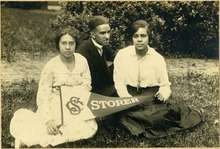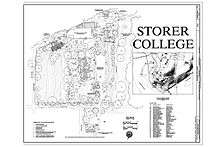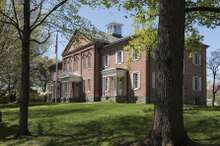Storer College
Storer College was a historically black college in Harpers Ferry in Jefferson County, West Virginia. Originally a normal school to train black teachers, it operated from 1865 to 1955. Established after the American Civil War with the help of philanthropic Baptists from New England, especially Maine, it lost state funding after the Brown v. Board of Education ruling by the US Supreme Court, which declared that segregated public schools were unconstitutional. The state decided to fund other facilities that could offer more education.
 Storer College postcard (1940)[1] | |
Former names | Storer Normal School |
|---|---|
| Active | 1865–1955 |
| Location | , , 39°19′25.64″N 77°44′7.49″W |
The defunct college's former campus and buildings were acquired by the National Park Service (NPS), authorized in a 1962 appropriation, as part of what is now called the Harpers Ferry National Historical Park. At the same time, the NPS began to develop this facility for use as one of its four national training centers.
History
Storer School


Founded as a one-room school for freedmen, Storer developed over the decades as a full-fledged degree-granting four-year college open to all races, creeds, and colors, and men and women. Former slaves came to Storer as they were eager to learn to read and write, to help them make their way in a new world of free labor. Some wanted to learn new skills and leave the agricultural fields where most had worked.
Educating freedmen
The first building on Camp Hill, a portion of Harpers Ferry, Virginia, to open its doors to students was the Lockwood House, formerly the US Armory Paymaster's quarters. In 1865, as a representative of New England's Freewill Baptist Home Mission Society, Reverend Nathan Cook Brackett established a primary school in the war-torn building. He taught reading, writing, and arithmetic to the children of former slaves and sometimes to their parents.[2][3]
This school was related to a larger national effort by Northern philanthropic organizations and the government's Freedmen's Bureau to set up schools in order to educate the millions of African Americans freed by the 13th Amendment to the US Constitution. From Harpers Ferry, Reverend Brackett directed the efforts of dedicated missionary teachers, who provided a basic education to thousands of former slaves congregated in the relatively safe haven of the Shenandoah Valley by the end of the American Civil War.
Teaching teachers
Dedicated as they were, these few teachers could not begin to meet the educational needs of the freedmen in the area. Across the South, education of freedmen was an urgent priority within their community. By 1867, some 16 teachers struggled to educate 2,500 students. Reverend Brackett realized that he needed to train African American teachers.
In 1867, Reverend Brackett's school came to the notice of John Storer, a philanthropist from Maine, through Rev. Oren B. Cheney, founder of Bates College, a Freewill Baptist school in Maine. Storer offered a $10,000 grant to the Freewill Baptists for a "colored school" in the South if several conditions could be met. First, the school must become a degree-granting college. Second, the school had to be open to all applicants, regardless of race or gender. And, finally, the Freewill Baptist Church had to match his $10,000 donation within the year. After a year-long effort, the money was raised, and Storer Normal School opened its doors. By March 1868 it received its state charter.
Local attitudes
Raising $10,000 turned out to be easy compared to facing local resistance by whites to a "colored school." Residents of Harpers Ferry tried everything from slander and vandalism to pulling political strings in their efforts to shut down the school. One teacher wrote, "it is unusual for me to go to the Post Office without being hooted at, and twice I have been stoned on the streets at noonday."[4] Threats by the Ku Klux Klan caused the faculty and students to carry arms while walking outside.[4]
These efforts did not succeed in closing Storer Normal School, and eventually, local attitudes changed. Later in his life, Reverend Brackett became a respected citizen of Harpers Ferry.
The three Rs and more

Understanding that former slaves needed to learn more than the three Rs to function in society, Storer founders intended to provide more than a basic education. According to the first college catalog, students were to "receive counsel and sympathy, learn what constitutes correct living, and become qualified for the performance of the great work of life." In its early years, in the press to expand literacy among the freedmen and their children, Storer taught freedmen to read, write, spell, do sums, and to go back into their communities to teach others these lessons.
Storer remained primarily a Teachers College, but added courses in higher education as well as industrial training. Students graduated with a normal degree, for teaching elementary school students, or an academic degree, for those going on to college. Buildings were constructed through the 1930s, with Permelia Eastman Cook Hall, a handsome grey stone building, completed 1939-1940.[1]
Civil rights
Frederick Douglass' speech, 1881
Storer College was a site of various important events in West Virginia and national African-American history.[5] In 1881, the noted abolitionist Frederick Douglass, who had escaped slavery as a young man in the antebellum years and become a noted orator, delivered his famous speech on abolitionist John Brown at Storer Normal School.[6]
Niagara Movement conference, 1906
In August 1906, Storer Normal School hosted the second conference of the Niagara Movement and the first on American soil. Formed by a group of leading African American intellectuals, the Niagara Movement planned a campaign to eliminate discrimination based on race. The movement's leader, W. E. B. Du Bois, a sociologist with a PhD, rejected the prevalent theory of "accommodation" promoted by Booker T. Washington. President of the Tuskegee Institute, Washington advocated conciliation and advancement of the race rather than confrontation as a means of gaining social equality. He encouraged the teaching of conservative rural and industrial skills at his campus to prepare students for the rural worlds most would return to.
The Niagara Movement published an annual "Address to the World", demanding voting rights (the mass of African Americans in the South had been essentially disenfranchised at the turn of the century by southern states, educational and economic opportunities, justice in the courts, and recognition in unions and the military. Many conservative African American and white leaders became alienated by their approach, which eroded potential political support. During the 1906 conference, Storer staff expressed discomfort with the group's militancy and dismay at their tendency to consider even progressive whites as the enemy.
By 1910, five years after it was formed, the Niagara Movement was dissolved. While it did not produce material gains in the civil rights arena, its leaders had announced their intention to pursue full civil rights, thereby laying a valuable foundation for the development of a more broad-based push for equality.
The National Association for the Advancement of Colored People (NAACP) was formed in New York City in 1910 with an interracial board, and many of the members of the failing Niagara Movement quickly joined it. The NAACP had many of the same goals of the Niagara Movement; it also pursued a concentrated program of litigation campaigns in the effort to overturn of barriers to voter registration and voting, end state and local jurisdictions' segregation of housing, gain integrated public transportation and other facilities, seek integrated public education, achieve fair jury trials for blacks, and similar goals.
Storer College

In 1938, under the leadership of school president Henry T. McDonald, Storer became a four-year college. The last new building was completed in 1939-1940. Enrollment peaked at around 400, as Storer and other colleges had struggled during the privations of the Great Depression. The number of students dipped lower with the high rate of participation by young men in World War II. The college had received some financial support from the state of West Virginia, as it helped educate blacks, who were limited to segregated schools and colleges.
Although the school granted four-year degrees, it never received regional accreditation. As a result, it was forced to turn away some students. Those who wanted to be doctors, for example, were not admitted. The college was unable to develop the necessary facilities to properly prepare students for such advanced studies that required investment in laboratories and other scientific facilities.
Closure of the College
In 1954, the NAACP achieved a victory with the US Supreme Court decision in the Brown v. Board of Education case, which declared racial segregation in public schools to be unconstitutional. "The West Virginia Legislature withdrew its annual appropriation from Storer because of the Supreme Court ruling outlawing segregation in public schools, and the resultant policy of integration in state schools. The Legislature said the appropriation was intended to finance studies by Negro students at Storer but is now unnecessary because Negroes now are eligible to enroll at other state colleges. The enrollment at Storer has been exclusively Negro." The state appropriation was $20,000. In its final year, the College had 88 students.[7]
Storer had been accumulating debt for a decade, and could not survive without the state appropriation. In June 1955, Storer College closed its doors forever. (West Virginia has continued to support Bluefield State College and West Virginia State University, larger historically black colleges that achieved regional accreditation and could offer more types of classes.)
Legacy
In 1962, Congress appropriated funds for the National Park Service to acquire the surviving buildings on campus as part of what is now known as Harpers Ferry National Historical Park. It had been established in 1944 as a National Monument, taking in much of the declining town.
As part of this change, in 1964, the movable physical assets of the college were transferred to the historically white Alderson-Broaddus College, a Baptist college, and used to establish scholarships for black students. The college's endowment was transferred to Virginia Union University, a historically black college.
Since 1964, Virginia Union University has considered, and treats, graduates of the college as alumni of VUU. VUU's L. Douglas Wilder Library and Learning Resource Center holds Storer College's former library collection and some of the college's records.[8] Other Storer College records are held at the library of Harpers Ferry National Historical Park, West Virginia University's West Virginia and Regional History Center, and at Howard University's Moorland–Spingarn Research Center.
The campus of the college is now maintained as a part of the Harpers Ferry National Historical Park. The three remaining college structures now house the National Park Service's Stephen T. Mather Training Center and the Service's library. The Training Center is one of four major training centers operated by and for the National Park Service. It is named for the Service's first Director, Stephen Mather.
Each August, the alumni of Storer College gather in Harpers Ferry for an annual reunion. At last count fewer than 70 alumni survive.
Notable alumni and faculty
| Name | Class year | Notability | Reference(s) |
|---|---|---|---|
| John Dunjee | Prominent Free Will Baptist preacher and early fundraiser for Storer | ||
| J. R. Clifford | 1875 | first African-American attorney from WV | |
| Hamilton Hatter | 1878 | first president of Bluefield State College, inventor | |
| John Francis Wheaton | 1882 | First African American member of the Minnesota State Legislature[9] | |
| Lewis Penick Clinton | West African prince and Baptist missionary | ||
| Jared Maurice Arter | Writer, missionary, academic | ||
| Robert Page Sims | 1887 | college president, academic, civil rights leader | |
| Stella James Sims | 1893 | professor at Storer College and Bluefield State College | |
| Don Redman | arranger for the Fletcher Henderson Orchestra during the 1920s and 1930s. He also played saxophone and clarinet in the group. | ||
| Nnamdi Azikiwe | 1926 | First President of the Federal Republic of Nigeria |
References
- HISTORIC AMERICAN BUILDINGS SURVEY ADDENDUM TO STORER COLLEGE, COOK HALL (Permelia Eastman Cook Hall), p. 3. Note: Permelia Eastman Cook Hall was not constructed until 1939-1940., HABS Survey, Library of Congress
- "Harpers Ferry National Historical Park - Storer College (U.S. National Park Service)".
- "Storer College".
- http://www.wvculture.org/history/education/storer.pdf Miss Kate J. Anthony, "A Brief Historical Sketch of Storer College 1887-1891" Harpers Ferry W. VA. (1891), pg 10-11 -Reproduced through West Virginia Division of ... www.wvculture.org/history/education/storer.pdf
- Shapiro, Stephanie; Shapiro, Stephanie (21 October 2015). "A black college closed in 1955, but its fading alumni fight to pass on a legacy". The Washington Post.
- Douglass, Frederick (1881). John Brown. An address by Frederick Douglass, at the fourteenth anniversary of Storer College, Harper's Ferry, West Virginia, May 30, 1881. Dover, New Hampshire.
- "Storer College To Close Down For Fund Lack". The Daily Mail (Hagerstown, Maryland). April 14, 1955. p. 8.
- "Virginia Union University | Records of Storer College". www.vuu.edu. Archived from the original on 2015-09-05. Retrieved 2016-08-17.
- An Ebony Legislator, St. Paul Daily Globe, February 12, 1899, accessed December 15, 2010.
External links
- Storer College Digital Collection at West Virginia and Regional History Center https://storercollege.lib.wvu.edu/
- Historic American Buildings Survey (HABS) No. WV-277, "Storer College, Harpers Ferry, Jefferson County, WV"
- HABS No. WV-277-A, "Storer College, Anthony Hall"
- HABS No. WV-277-B, "Storer College, Mosher Hall"
- HABS No. WV-277-C, "Storer College, Lewis Anthony Library"
- HABS No. WV-277-D, "Storer College, Brackett Hall"
- HABS No. WV-277-E, "Storer College, Cook Hall, 252 McDowell Street"